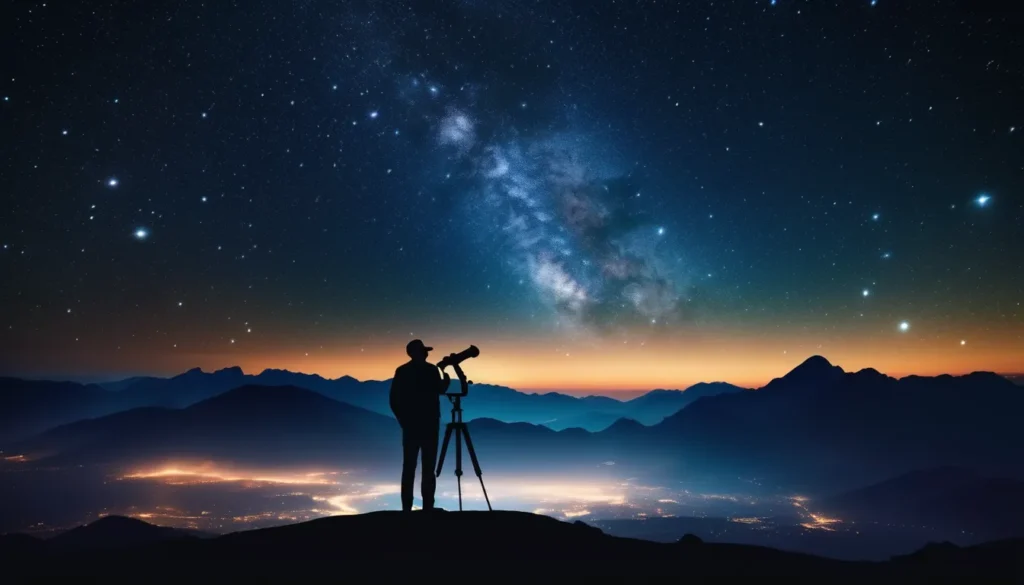Hello, everyone! Have you ever counted the stars and then felt a bit shocked asking, “How many stars are in the world?”. Stars are still very few of the many things that the universe invented. This space problem has always been a mystery to both astronomers and even the casual star gazers. The scene is very complicated, but modern astronomy has made it possible to deploy better tools and methods to conduct what can be called as a celestial census.
This particular blog covers space’s infinite expanse, how the stars formed, why it’s so hard to count them, and the absolute huge numbers that are space’s bulkiness. The visible universe is indeed an extremely wide extension, extending to 93 billion light-years in diameter.
Thus, it contains a wealth of galaxies, stars, planets, and other celestial bodies. Well, if there are so many stars, it then must be remembered that space is not empty. The contrary, it is a big nearly limitless and ever-changing huge galaxy in which multiple galaxies with different numbers of stars reside.
let us have a quick brief for the elementary facts about a star!
What is a Star?

Essentially, a star is a ball of gas. Hydrogen and helium are the two main constituents, which star undergoes nuclear fusion at its core. Such fusion causes the release of enormous amounts of energy outside the star in light or heat. Stars differ from each other in sizes, temperatures, and life spans.
Red dwarfs or minimal ones can be larger than hundreds of times of the size of our sun and include super gaints These include almost all possible types and counts due to the difference, ages cycle included, from very young and vibrant, luminous ones to old-aged dying stars known as white dwarfs or neutron stars.
Star Clusters of Cosmic Galaxies
While a galaxy houses thousands to billions of stars, it cannot be confined to anywhere outside in the void of space. A huge mass of dust, gas, and dark matter in stars is pulled by the gravitational forces of the Milky Way and other littler, huge structures. Certainly, billions of galaxies exist more in the whole world, and from each of them we can say, there are billions of stars.
Some galaxies, like the short-lived dwarf ones, might have a few billion stars, while our very own Milky Way has 100 to 400 billion stars along with some such immense galaxies like Andromeda that have over a trillion stars to boast.
Counting the Stars: An Impossible Task

An effort to count the stars in space could be as difficult as any. What would be some of the challenges?
Travelling with Distance and Light The farther a star is from Earth, the longer it takes for light from it to reach us: decades, even millions of years! Humans cannot see stars as they are in real time.
Observable Universe Finite number of stars comprise the limit of the observable universe, or all space that has had time to reach us since the Great Explosion. Who knows how many more stars are out there but still remain unknown to our current view of the universe?
Hidden Stars: such as those caused by interstellar dust. Some of these stars are thus hidden and not visible to optical telescopes. Other hidden stars include such as black holes or neutron stars: It emits very little or hardly any light, rendering it invisible to human eyes.
Technological Limitations Indeed, even the more modern telescopes at present such as the Hubble Space Telescope and James Webb Space Telescope have contributed to huge enhancements to reach distant stars. Still, without poor image clarity but the enhancement is still a lot to be desired.
Counting stars is difficult, so astronomers instead use estimates and approximations. Some of those are derived from carefully surveying particular areas. We are exploring the night skies, as well as our comprehension of the birth and evolution of stars.
Best guess: How many stars there are in the universe?
- How many stars are there in space? Well, no one knows but, with any luck, astrologers will have some ideas.
- There are about 200 billion stars on the Earth itself, whereas each galaxy contains between 100 million to one trillion stars.
- According to astronomers, the whole cosmos comprises between 10^22 and 10^24 stars.
- That is an unfathomable number, approximately 10,000 stars for the whole world.
Methods of Estimation
It is really baffling how astronomers manage to obtain such statistics. There exist numerous techniques to do so:
- Star surveys: Telescopes such Hubble and Gaia control enable proper surveys of the stars, mapping their positions, distances, and luminous stars in our galaxy and even those in adjacent galaxies.
- Redshift and Light Analysis: By examining the light emitted from remote galaxies, one can quantify the masses of such galaxies and the stars in their vicinity. The bigger the galaxy, the more stars it will likely contain; this method also aids astronomers in comparing the mass among galaxies.
- Galactic Evolution Models: The evolutions of galaxies are modeled from the time of their birth to the present. Given how stars happen to be formed, astronomers are able to estimate how many must be found in a particular galaxy at any given time in its history.
Are New Stars Still Being Born?
Absolutely! The universe is not dead; it is alive, in constant change. New stars are born in stellar nurseries—basically, regions of space filled with gas and dust. As the clouds of gas collapse under gravity, they form new stars. This has continued right up to the present, billions of years after the formation of the first stars.
However, the rate of star formation has declined in recent epochs. Star formation is much more energetic in the first few billion years after the Big Bang. The universe itself is still giving birth to stars, but it is losing them as they grow old and die. Some explode in large supernovae, while others quietly fade away into the background.
Will we ever know for sure the future of star counting?
Perhaps, we might not. The number, indeed, is too great to be counted with counting systems and technology available at present. Increased information might give astronomers additional data necessary for estimating their numbers more accurately. New advanced technology will likely discover galaxies, stars, or phenomena yet unknown. The present modern world will eventually take us to the truth of galaxies in the next years.
Why Does All This Matter?
Counting the stars is an act that might not sound very abstract but could have some strong connotations in a way that would matter strongly to the understanding of the universe. It allows us to understand how many stars form, how they evolve, and even the ultimate fate of the universe. It is all part of understanding planets: every star is predicted to have some planets, and a few of them might hold life. By examining the stars, we search for our cosmic neighbors as we look within the cosmos to understand ourselves better.
Conclusion
There is, of course, no way to count stars in the cosmos. Nevertheless, the estimates are astronomically mind-boggling-from the 100 billion in the Milky Way to the sextillion scattered throughout billions of galaxies. The place approaches incomprehensible both in scale and beauty. This census of stars, far from exhaustive, serves to remind us how tiny we are and how much more we have to learn. Whether professional or otherwise, the stars will always draw us in and give one a glimpse into how mysterious the universe and all the possible infinite things beyond are.
FAQ
What would be the number of stars that the world can have?
Two hundred billion trillion stars.
How many stars in the sky?
According to astronomers, there might be about one septillion stars in the universe, of which over 100 billion stars are present in our home galaxy alone, the most researched of which is our Sun.
Which are the seven stars visible in the sky?
An ancient Chinese astrological theory combines seven distinct star groupings to symbolize different sky locations, calling them the “Seven Celestial Stars.” The Seven Constellations are Sun, Lunar Moon, Taibai, Year Star, Chen Star, Yinghuo, and Filling Star/Neutralizing Star.
What can be counted among the stars in the universe?
You can indeed count stars, but all those indeterminate number of them would make it impossible for one to count them.




